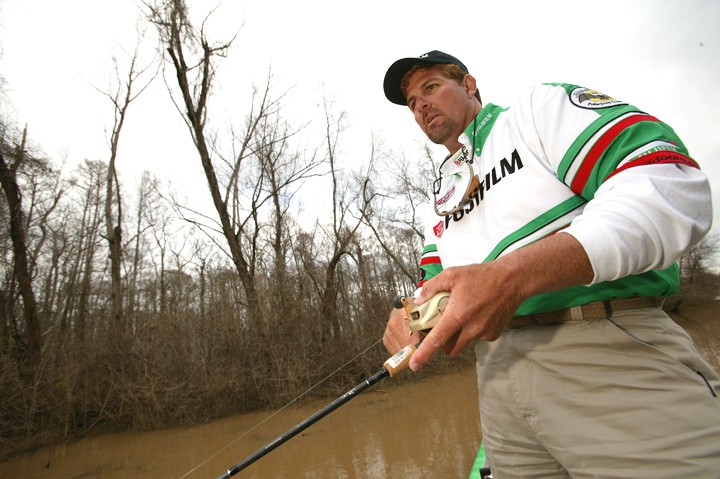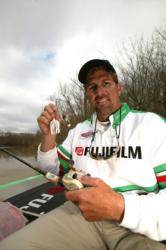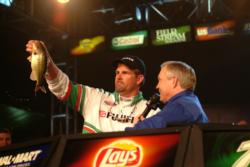Bayou bass with Sam Swett
Fujifilm pro details winning Atchafalaya Basin techniques

“Some people say a bass is a bass no matter where you go, but I don’t think that’s necessarily true,” professes Sam Swett with a Cajun-cured inflection. “Humans are humans, but we have different cultures, customs, cuisines and dialects based on where we are from. It’s the same with bass. Sure, all bass have scales and fins, but when it comes to their feeding habits and behavior patterns, those are largely determined by their environment.”
Sam Swett should know. For the last 12 years, the Covington, Louisiana-based bass pro has been fishing across America learning the habits of bass in all parts of the country. He recently won the FLW Tour stop in his back yard at the Atchafalaya Basin in Louisiana by knowing a few things about bayou-bass behavior.
The first intrinsic clue Swett had about fishing in South Louisiana in February was the behavior of crawfish. As a kid, Swett used to set crawfish traps in the Louisiana bayous. When the water turned unusually cold, he remembers the crawfish hibernating in the mud.
“In coastal Louisiana, where there is a great deal of saltwater intrusion, crawfish can’t go to deep water like they can in a freshwater lake,” Swett explains. “The salt water is dense and it sinks to the bottom, so the crawfish are forced to crawl up in the bayou and burry themselves in the mud when it gets cold.”
The Fuji pro says that when it gets really cold, crawfish are actually a problem in lawns.
“For people who have yards near the bayous, the crawfish will devastate their lawns by burrowing and tunneling into their yards,” he adds.
So what do burrowing crawfish have to do with winning a bass tournament?
“Pitching and flipping craw-imitating baits – plastic craws, jigs and tubes – is a predominant way to catch bass in Louisiana,” Swett says. “But when I saw how cold the water was and how it was dipping towards the 50-degree mark in practice, I figured a shad-imitating game plan was going to be better.”
Swett knew that the closer he got to the “marsh,” where water is influenced by tides in the Gulf of Mexico, the more bass would be munching on shad rather than crawfish, so that’s where he decided to practice.
Swett’s move to the marsh was also predicated on the observation that man-made oil canals in the basin washed out too easily.
“All it takes is a boat wake or two in one of those canals, and it washes the silt off the bank and turns the place to mud for an hour,” he says. “I wanted to find a natural bayou with clear water that was being filtered by the marsh and vegetation.”
Swett’s search for clear water, vegetation and shad led him toward the Intracoastal Waterway where he discovered a bayou about three miles from the Gulf of Mexico that had clear water draining from it.
The skinny bayou was lined with matted hydrilla. At first, the Fuji pro considered flipping the mats. But when he put his temperature probe (on the end of his trolling motor) into the thick grass, he realized the temperature in the mats was not any warmer than the water in the bayou.
“When it’s sunny, those mats absorb heat, and the water around them can be significantly warmer,” he says. “Bass will usually get under the mats and feed on any crawfish living in that warmer environment. But when I saw that the mats were holding no heat and knowing that the forecast for the tournament was for clouds, that only convinced me more that I needed to put the flipping rods down and stick with shad-imitating baits.”
 During his first encounter with the two-mile-long winding bayou in practice, Swett threw a spinnerbait and instantly hooked up with a couple of solid keepers.
During his first encounter with the two-mile-long winding bayou in practice, Swett threw a spinnerbait and instantly hooked up with a couple of solid keepers.
“What excited me about those first few bass was that they had been eating shad,” he recalls. “I could see shad in their throats and I smelled shad on them, and that’s exactly what I was looking for.”
Then Swett did something different than he normally does during practice.
“I kept fishing and exploring the bayou,” he says. “Usually, if I catch a few keepers in an area in practice, I immediately leave because I don’t want to hook them before the tournament. But, in this case, I spent the rest of the day fishing in there, and I’m glad I did because I learned a lot about the place.”
Specifically, Swett learned how the current played a big role in where the fish were positioning and feeding. He learned where all of the prime ambush targets were located. In essence, he became attuned to the area, and his observations paid off in the tournament.
“In the tournament, I caught all of my fish on a Booyah Blade spinnerbait,” he says. “I would slow-roll the bait, with the current, down the vertical walls of hydrilla that were 7 to 8 feet deep. Fish were using irregularities in the grass wall, like protruding clumps or `shelves’ in the grass that would block current and create ambush points.”
Swett had to slow-roll the spinnerbait nearly out of sight in 5 or 6 feet of water to get bites. In order to compensate for the different levels of current flow, he used three different sizes of the Booyah Blade: 1/4-ounce, 3/8-ounce and 1/2-ounce. All three sizes were in the same color (Glimmer Blue) and had the same blade configuration: two Colorado blades, a silver one in the front and a gold one on the back.
 He fished all three on 14-pound-test Silver Thread AN40 line.
He fished all three on 14-pound-test Silver Thread AN40 line.
“Contact with the grass was critical,” he explains. “I would parallel the grass lines and slow-roll the bait out of sight. When the current was real heavy, I had to use the 1/2-ounce Booyah Blade. When the tide was slack and there was no current, I used the 1/4-ounce; the 3/8-ounce one came in handy during the in-between currents. But nearly all my bites came when I contacted the grass on an ambush point and ripped the bait free. The thinner diameter of the AN40 helped get the bait down where it needed to be.”
In Cajun country everything revolves around the crawfish, including Sam Swett’s $100,000 Wal-Mart FLW Tour victory at the Atchafalaya Basin.